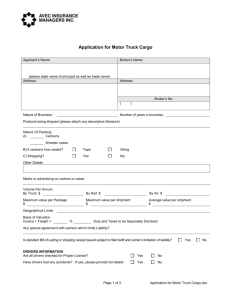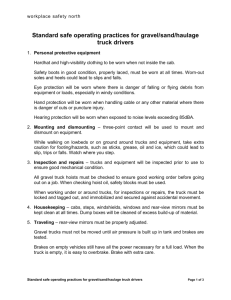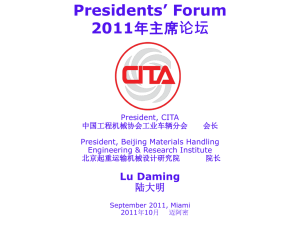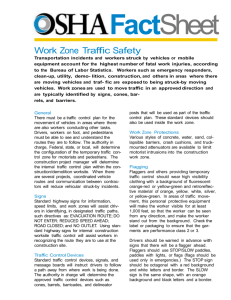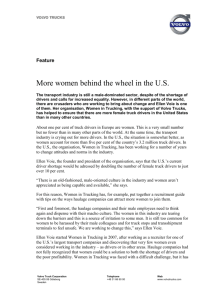CLEANAWAY – (Case Study of a Service business for Operations
advertisement
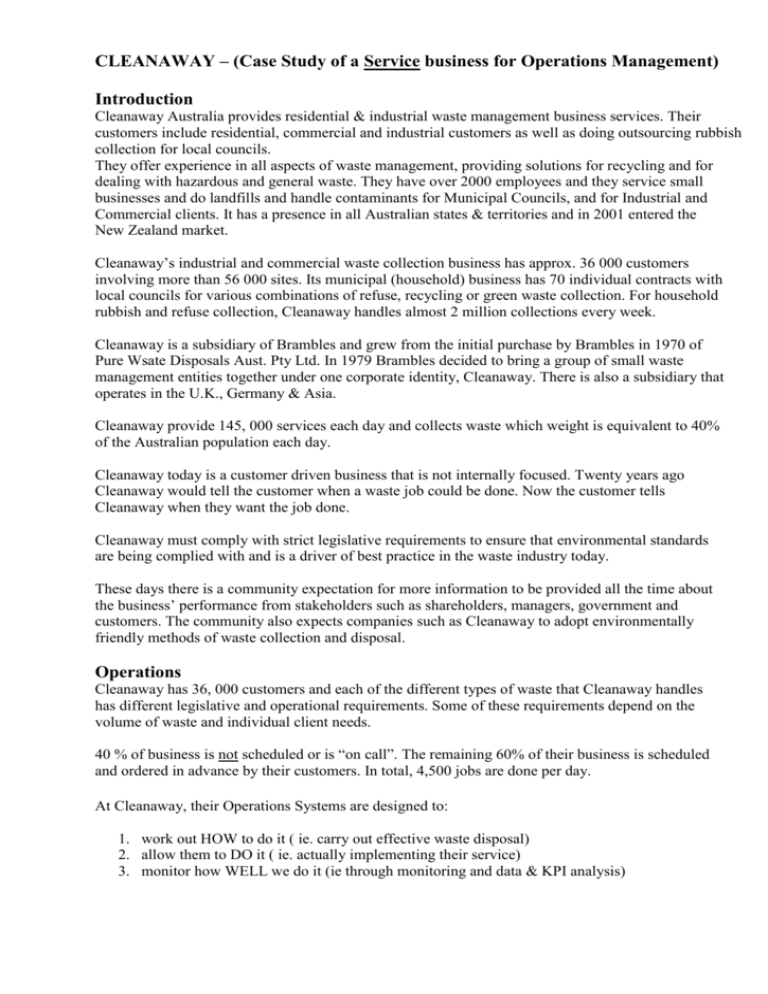
CLEANAWAY – (Case Study of a Service business for Operations Management) Introduction Cleanaway Australia provides residential & industrial waste management business services. Their customers include residential, commercial and industrial customers as well as doing outsourcing rubbish collection for local councils. They offer experience in all aspects of waste management, providing solutions for recycling and for dealing with hazardous and general waste. They have over 2000 employees and they service small businesses and do landfills and handle contaminants for Municipal Councils, and for Industrial and Commercial clients. It has a presence in all Australian states & territories and in 2001 entered the New Zealand market. Cleanaway’s industrial and commercial waste collection business has approx. 36 000 customers involving more than 56 000 sites. Its municipal (household) business has 70 individual contracts with local councils for various combinations of refuse, recycling or green waste collection. For household rubbish and refuse collection, Cleanaway handles almost 2 million collections every week. Cleanaway is a subsidiary of Brambles and grew from the initial purchase by Brambles in 1970 of Pure Wsate Disposals Aust. Pty Ltd. In 1979 Brambles decided to bring a group of small waste management entities together under one corporate identity, Cleanaway. There is also a subsidiary that operates in the U.K., Germany & Asia. Cleanaway provide 145, 000 services each day and collects waste which weight is equivalent to 40% of the Australian population each day. Cleanaway today is a customer driven business that is not internally focused. Twenty years ago Cleanaway would tell the customer when a waste job could be done. Now the customer tells Cleanaway when they want the job done. Cleanaway must comply with strict legislative requirements to ensure that environmental standards are being complied with and is a driver of best practice in the waste industry today. These days there is a community expectation for more information to be provided all the time about the business’ performance from stakeholders such as shareholders, managers, government and customers. The community also expects companies such as Cleanaway to adopt environmentally friendly methods of waste collection and disposal. Operations Cleanaway has 36, 000 customers and each of the different types of waste that Cleanaway handles has different legislative and operational requirements. Some of these requirements depend on the volume of waste and individual client needs. 40 % of business is not scheduled or is “on call”. The remaining 60% of their business is scheduled and ordered in advance by their customers. In total, 4,500 jobs are done per day. At Cleanaway, their Operations Systems are designed to: 1. work out HOW to do it ( ie. carry out effective waste disposal) 2. allow them to DO it ( ie. actually implementing their service) 3. monitor how WELL we do it (ie through monitoring and data & KPI analysis) Inputs - 700 specialist vehicles designed to collect and transport a broad range of solid and liquid wastes enabling it to provide a quick and effective service for its customers. Cleanaway has made a huge investment in creating the largest and most modern fleet of waste management trucks in Australia. - 650 truck drivers who are trained in how to operate all the equipment on Cleanaway waste management vehicles - Computerised Routing system which coordinates all jobs including time, location, driver, type and volume of waste, any treatment required and destination for waste - Fuel, Tyres, Parts, Hydraulics,etc. - Waste Treatment equipment Processes - Bin recycling system which services more than 770, 000 Australian households - Collection of rubbish & refuse - Identification, treatment and disposal of various types of waste - Routing of specific jobs ie. best routes for drivers to take to each job to minimise “dead time” (ie. travelling between jobs is non productive time at the company’s expense so productivity is crucial) - Scheduling of jobs ie. times and demands of each job and coordinating drivers and vehicles to specific customer requirements - Training of truckdrivers in use of vehicles, and identifying, trating & handling various types of waste. - Recruitment & Training of Management & Administrative staff - Monitoring drivers, success of jobs and whether K.P.I.’s have been reached - Repair & Maintenance on Vehicles Outputs - Quality waste disposal - Treatment of hazardous waste - Rubbish Collection - Solutions for recycling - Solutions for Landfill operations Operational Management Strategies a) Management Of Technology - Cleanaway uses an Information Technology Routing System to control the jobs. This computerised system coordinates the timing, the best & quickest routes for Cleanaway trucks to get to a site, specific demands of the job and where to take the waste to. This Routing System maps all the known barriers and restrictions to a job for the truck drivers and provides a clear pictorial system of the deployment of Cleanaway trucks. - This system also includes an Interactive Voice Response (IVR) system whereby truck driver & service centre interact on the requirements of each job. It reduces the need for manual intervention and is cost effective. - All vehicles have on board Victor computers at a total cost of $20 million. The Victor computer system on each truck records: * the weight of waste for that job * the time spent at the site * time spent getting to the site This computer system reduces the administrative workload, increases accuracy and allows for detailed profitability analysis. (There was some initial resistance to the use of the computers in the trucks by the drivers as they disapproved of the strict supervisory method it brought to their work as well as having a natural reluctance to use computers. Cleanaway helped solve these HR issues through improved remuneration packages for their truck drivers. Proper training to help the drivers feel confident in using the computers. This took 4 months to complete with the assistance of two trainers) -Electronic Fuel Recording Systems to monitor fuel usage and efficiency ti monitor a major cost of the business. b) Management Of Quality -A National Data Warehouse was established where an enormous quantity of data was collected on customers, types of waste disposal jobs carried out and the efficiency of Cleanaway’s vehicles and drivers. This data warehouse used an integrated computer system to establish trends and benchmark Cleanaway’s performance against world’s best practice. - Quality Assurance is used and Cleanaway has been independently assessed and is accredited and certified at ISO 9001. The Quality Management Systems support the operations of the business but not dictate it. - User friendly Quality Management Systems are used to make it more convenient for management and employees to take joint responsibility to ensure that quality targets are being met. - The Cleanaway Business Model maps out every business process (ie over 7,500 in total). This model reviews a customer complaint and finds out why the proper service wasn’t carried out. ( 90% of all customer complaints are because the model wasn’t followed and employees have tried to “cut corners.” - KPI’s used to measure quality include reports on conformance. ie. the degree to which Cleanaway’s work coforms to the requirements of its customers. Currently it has a conformance rate of 99.7%. - Customer surveys are also utilised where Cleanaway is able to ascertain qualitative feedback from individual customers as to how satisfied they have been with the waste disposal service provided. Results have been very encouraging with a very high level of customer satisfaction being realised. - Other KPI’s include Sales targets, Sales Productivity (ie value of sales compared to costs), truck output, costings per job, time taken per job, kilometres per truck, hours per truck on jobs, Value of Assets, Annual Profit, etc. c) Materials Management - The Maximo Fleet of 700 specialist vehicles represents a $25 million capital investment. Outsourcing the task to other companies for drivers & trucks was not going to be economical because 3rd parties were not going to have the sense of urgency that in-house truck drivers could provide. - This large capital investment also includes management and ordering of fuel, repair & maintenance, tyres, parts & hydraulics. Vehicles are regurlarly serviced and maintained to improve their productivity and effectiveness as well as prolonging their life. - The Recycling Services include Colour coded Containers to classify different types of waste. Ie. Yellow bins (Medical Waste), Purple bins ( Cytoxic Waste, which has to be disposed of by high incineration) - A new innovation has included the Bio-Bin that includes an insert to assist in breaking down green waste by 50%. This means trucks only need to collect twice a month instead of 4 times a month. d) Facilities Design & Layout - Service Centres are organised so that when a customer calls for a job to be done, they talk directly with the nearest service centre who will actually dispatch the truck to the job. - National Data Warehouse established to record all business processes, and customer requirements and job performance. This greatly assists in improving customer service, monitoring Cleanaway productivity and profitability. - Maintenance & Repair Centre to service trucks and vehicles - Training Centres for management and drivers - Administration offices Overview Cleanaway recognise that their Operational Systems will need to continually change in the future as the business continues to change, grow and further expand and as the demands of their customers changes also. The skills set required to satisfy the waste disposal industry is ever broadening. The continual challenge for Cleanaway is to get the “right balance” between efficiency and customer responsiveness.


